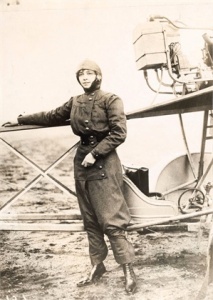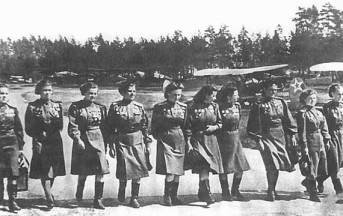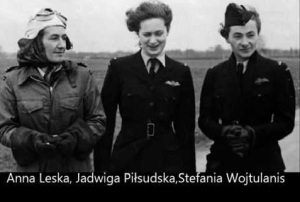We have all heard of female aviators and their accomplishments: Harriet Quimby the first American woman to earn a pilot’s license; Amelia Earhart the first female aviator to fly solo across the Atlantic Ocean; and Bessie Coleman the first African-American (male or female) to earn a pilot’s license. However, there are many unsung female aviation heroes that lent their flying skills to war efforts in Europe during the First and Second World Wars.
InspiredByMyMom.com has chosen to bring attention to some of these female aviators who flew during wartime or in combat missions in honor of Women’s History Month this year.
 Born in France in 1875, Marie Marvingt and her family moved to Metz, at that time part of Germany, in 1880. When Marie’s mother died in 1889, the 14 year old along with her father and brother moved back to Nancy where she found herself in charge of a household while devouring books by explorers and scientists.
Born in France in 1875, Marie Marvingt and her family moved to Metz, at that time part of Germany, in 1880. When Marie’s mother died in 1889, the 14 year old along with her father and brother moved back to Nancy where she found herself in charge of a household while devouring books by explorers and scientists.
She was encouraged to participate in sports by her father and, it is said, that at the age of 5 she had already swum 4000m in a single day. Marvingt became a world-class athlete who won numerous prizes in swimming, fencing, shooting, ski jumping, speed skating, luge and bobsledding and, in 1899, she earned her driving license.
Her interest in aviation began when she ascended into the skies as a passenger in a free-flight balloon for the first time and on July 19, 1907 she piloted one for the first time. In 1909 she became the first woman to pilot a balloon from Europe to England across the North Sea and English Channel.
Later the same year, Marie experienced her first flight as a passenger in an aeroplane and the next year she piloted and flew solo in an Antoinette monoplane, the first woman to do so. On November 8, 1910 she earned her pilot’s license No. 281 from the Aéro-Club de France – only the third Frenchwoman to be registered.
In her illustrious career, she competed for the Femina Cup (Coupe Femina), proposed the development of fixed-wing aircraft as air ambulances to the French government and, during the start of WWI, she disguised herself as a man and served on the front lines with the 42nd Battalion of Foot Soldiers – until she was discovered and sent home. She later participated in military operations with the Italian 3rd Regiment of Alpine Troops in the Italian Dolomites at the direct request of Marshal Ferdinand Foch.
In 1915, Marvingt became the first woman in the world to fly combat missions when she became a volunteer pilot flying bombing missions over German-held territory during WWI. She received the Military Cross (Croix de guerre) for her aerial bombing of a German military base in Metz.
Marvingt devoted the remainder of her long life to the concept of aero-medical evacuation, giving more than 3000 conferences and seminars on the subject on at least four continents. She was co-founder of the French organisation Friends of Medical Aviation (Les Amies De L’Aviation Sanitaire) and one of the organizers behind the success of the First International Congress on Medical Aviation in 1929.
She was incontestably one of the greatest female aviation pioneers who ever lived when she died in 1963 – in total obscurity and poverty – after having enjoyed one of the most brilliant and exceptional careers of any woman in aviation history.
 These Soviet pilots did what anyone piloting a plane made of plywood would do when confronted with enemy fire, they ducked. They were known as the “Night Witches” and these female bomber pilots struggled to earn the respect of their brothers in arms during World War II.
These Soviet pilots did what anyone piloting a plane made of plywood would do when confronted with enemy fire, they ducked. They were known as the “Night Witches” and these female bomber pilots struggled to earn the respect of their brothers in arms during World War II.
The Night Bomber Regiment was one of three female fight pilot units created by Stalin at the urging of Marina Raskova, “the Soviet Amelia Earhart”. She trained her recruits as pilots, navigators, and ground maintenance crews. When a male general initially complained about being sent girls instead of soldiers they soon proved him wrong. The regiment flew both harassment and precision bombing missions against the German military from 1942 to the end of the war.
The Soviet Union was the first nation to allow women to fly combat missions which meant that they could return fire. These female pilots not only flew planes but they also dropped bombs. Every night, approximately 40 planes (each crewed by two women – a pilot and a navigator), would fly eight or more missions. The multiple nightly sorties were necessary because their modified crop-dusters were capable of carrying only two bombs at a time.
The Nazis named the female fighter pilots Nachthexen “Night Witches” because the noise of their flimsy wood and canvas biplanes reminded the Germans of the supposed sound of a witch’s broomstick swishing in the night. They were loathed, they were feared, and it is said that they flew over 23,000 sorties and dropped 3,000 tons of bombs.
Because their PO-2s were flimsy and flew near the ground, they could often pass undetected by radar. The pilots’ tactic was to fly to within a certain distance of the target, and cut their engines. They would then glide in silently, release their bombs, then restart their engines and fly home.
Nadezhda Popova, one of the Night Witches who passed away in 2013 in Moscow, flew 852 missions. Although she was shot down or forced to land several times, she managed to emerge unharmed. In her memoir she recalled one particularly grueling mission when, after bombing an ammunition dump, she found herself caught in the searchlights: “I manoeuvred and suddenly I saw them switch to another plane that flew after me. Enemy planes took off and shot it down, it caught fire and fell. That was one. Then I turned my head and saw a second plane go down in flames and then a third one lit up the sky like a falling torch. By the time I got back, four of our planes had perished with eight girls in them burned alive … What a nightmare, poor girls, my friends, only yesterday we had slept in the bunks together.”
“I sometimes stare into the blackness and close my eyes,” Ms. Popova said in 2010. “I can still imagine myself as a young girl, up there in my little bomber. And I ask myself, ‘Nadia, how did you do it?’ ”
The women of the 588th Night Bomber Regiment were brave fighters and they wore their moniker “Night Witches” as a badge of honor.
 During the Second World War, the Air Transport Auxiliary (ATA) was a British civilian organisation formed and charged with ferrying military aircraft between factories, assembly plants, transatlantic delivery points, maintenance bases, and active service squadrons and airfields. It also flew service personnel on urgent duty from place to place and performed some air ambulance work.
During the Second World War, the Air Transport Auxiliary (ATA) was a British civilian organisation formed and charged with ferrying military aircraft between factories, assembly plants, transatlantic delivery points, maintenance bases, and active service squadrons and airfields. It also flew service personnel on urgent duty from place to place and performed some air ambulance work.
The ATA recruited pilots who were considered to be unsuitable for the Royal Air Force (RAF) by reason of age or fitness. The ATA also took pilots from neutral countries and, most notably, female pilots. These women pilots were initially restricted to non-combat aircraft but they were eventually permitted to fly virtually every type of plane flown by the RAF and the Fleet Air Arm, including Spitfires, Lancasters, Hurricanes, and the 4-engined heavy bombers.
One of the many notable achievements for these women was that they received the same pay as men of equal rank in the ATA starting in 1943. This was the first time that the British government gave its blessing to equal pay for equal work within an organisation under its control. It should be noted that at the same time American woman flying with the Women Airforce Service Pilots (WASP) were receiving as little as 65 per cent of the pay given to their male colleagues.
Female pilots had to fight hard to prove themselves in a chauvinistic climate. In order to join the ATA, the females needed a minimum of 500 hours solo flying whereas men could join with only 250 hours. They had to fly the fighter aircraft with limited training and were often looked down upon by the male RAF pilots. However neither this nor the dangers they faced detered the women of the ATA.
Maureen Dunlop de Popp joined the ATA in 1942 and became one of a small group of female pilots based at White Waltham in Berkshire who were trained to fly 38 types of aircraft. She later recalled how she had to make an emergency landing when flying a Spitfire as the cockpit canopy blew off after takeoff. Another time she had to land in a field after the engine of her Argus aircraft failed in the air. Dunlop loved being behind the controls of a plane and while she clocked up more than 800 hours during her time with the ATA, she lamented the fact that women were not allowed to fly in combat.
Jadwiga Piłsudska, the younger daughter of Poland’s Chief of State Marshal Józef Piłsudski, fled to Britain in 1939 when the war broke out in Poland and went on to join the ATA. With Anna Leska and the Lithuanian-Pole Stefania Wojtulanis she was one of several Polish women who served with the ATA.
Helen Harrison-Bristol’s experience was directed towards pilot training in Canada when, in 1942, she was accepted as the first Canadian woman ferry pilot to serve with the ATA. The following year she co-piloted a Mitchell bomber across the North Atlantic from Montreal, Canada to Scotland, and until 1944, she delivered military aircraft within the United Kingdom.
After being told about the ATA by her friend and fellow pilot Violet Milstead, Marion Alice Powell applied, was tested in Montreal, and was admitted to the ATA. Both Orr and Milstead moved to England in the summer of 1942. Orr’s first flight for the ATA was on June 2nd, 1943 and her favorite aircraft was the Spitfire, which she considered “the most beautiful plane ever built.”
Jacqueline Cochran, a pioneer female aviator, tried to form an American auxiliary with female pilots, but with little interest from U.S. authorities she recruited 24 other women pilots to sail to the United Kingdom and join the ATA in 1942.
Ann Wood-Kelly was one of the pilots that joined the ATA with Jacqueline Cochran. During her time as a ferry pilot she flew more than 900 missions in 75 different types of aircraft ranging from the single-engine Supermarine Spitfire fighter to the four-engine Avro Lancaster heavy bomber.
The women of the ATA were courageous women that, although not flying combat roles, faced many dangers as often they had to fly in challenging weather conditions or under the cover of night. Some of them paid the cost of war with their lives including Amy Johnson who set numerous long-distance records during the 1930s and flew in WWII as a part of the ATA. She died in 1941 during a ferry flight from Blackpool to RAF Kidlington in the UK after baling out in cloud over the Thames estuary.
If you enjoyed the HERstory of these women you may also like to read these previous posts:
Remembering the Inspiring Women of World War I
Inspiring Women of WW I : The Hello Girls
Inspiring Women of World War I : Nurse and Poet Eva Dobell
You may also like to read other stories in this series.
March is Women’s History Month – Part 3 – Women in WAR
March is Women’s History Month – Part 2 – Women in ART
March is Women’s History Month – Part 1 – Women in STEM

Reblogged this on Cogpunk Steamscribe.
LikeLike
Thank you for sharing on your blog and allowing more people to learn about these incredible female aviators.
LikeLiked by 1 person
We need to address the inequality of the history taught in schools.
LikeLike
Shared on FB group “Women Who Rock.”
LikeLike
Thank you for spreading the word about these inspiring women.
LikeLiked by 1 person
Another wonderful post for Women’s History Month. I especially like the information about the “Night Witches”. And of course I shared on Saints, Sisters, and Sluts. Excellent post!
LikeLike
Thx a mil for the lovely comments & the repost. Much appreciated.
LikeLike
I have to tell you Betty, I am just loving this series! The courage and accomplishments of these women is so inspiring. I live in Hawaii and as you may know Kalaupapa on Molokai is a former leper colony and I’ve always been fascinated with the history. When doing some research on the area at Bishop Museum last year I discovered that a young woman who was a nurse is actually the one who came up with the cure for Hansen’s Disease (Leprosy) but of course the credit went to a male doctor who was her “superior.” It’s good to see more of these unsung heroes being introduced to the world.
LikeLike
Thank you for your lovely comments and I am so happy to hear that you are enjoying reading about these women. If you read Part 1 – Women in STEM – you’ll see that there is actually a term “The Matilda Effect” which is the systematic repression and denial of the contribution of women scientists in research and whose work is often attributed to their male colleagues. This definitely seems to have been the case with this young woman.
It’s interesting that you mention Molokai as I recently purchased a book by the same title written by Alan Brennert and I will now be reading it sooner rather than later.
Thank you for sharing and have a lovely weekend.
LikeLike
Wow wow wow! This women’s history is SO important – THANK YOU for sharing! Love Marie’s story and it’s heart-breaking that she died living in poverty.
LikeLike
Thank you for your kind comment… So many women with so little recognition which is why I try and bring their stories to light…
LikeLike
Another eye-opening teaching from you. I love what you do and what I learn from you. Night Witches! Wow. I’m sharing this everywhere, right now.
LikeLike
Thank you, Sue. There will be a few more for #WomensHistoryMonth 2016.
I learn so much while I research these because history did not really focus on #HERstory.
I am working on Women in Medicine right now… Stayed tuned…
LikeLike
What amazing history you are sharing in your series! One of the things I loved hearing is that in 1943 the women of the ATA were compensated equally for their work. This stood out as we are currently hearing so much about the ongoing inequality there is in the workplace between men and women doing the same work. It’s encouraging to have these stories surface so we can finally honor these women for their daring and courage. Thanks for the great research you are sharing Betty!
LikeLike
It makes my day when I see these positive comments as I love sharing the #Herstory of woman that have not received the recognition they so rightly deserve. It is sad that, although they understood equal pay in 1943, it is still a serious issue today… in 2016!
LikeLike